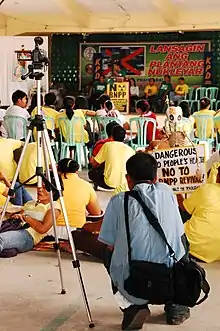Bataan Nuclear Power Plant
Bataan Nuclear Power Plant is a nuclear power plant, completed but never fueled, on Bataan Peninsula, 100 kilometres (62 mi) west of Manila in the Philippines. It is located on a 3.57 square kilometre government reservation at Napot Point in Morong, Bataan. It was the Philippines' only attempt at building a nuclear power plant. It was mothballed due to safety concerns in the wake of the 1986 Chernobyl Nuclear Power Plant disaster in the former Soviet Ukraine[1][2][3][4] and issues regarding corruption.[5][6][7]
| Bataan Nuclear Power Plant | |
|---|---|
 | |

| |
| Country | Philippines |
| Location | Morong, Bataan |
| Coordinates | 14°37′45″N 120°18′50″E |
| Status | Completed, but never launched |
| Construction began | 1976 |
| Construction cost | over $US2.3 billion |
| Nuclear power station | |
| Reactor type | PWR |
| Reactor supplier | Westinghouse |
| Power generation | |
| Nameplate capacity | 621 MW |
| External links | |
| Commons | Related media on Commons |
Background
The Philippine nuclear program started in 1958 with the creation of the Philippine Atomic Energy Commission (PAEC) under Republic Act 2067.[8] Under a regime of martial law, Philippine President Ferdinand Marcos in July 1973 announced the decision to build a nuclear power plant.[8] A presidential committee was set up to secure funding for two 620 megawatt nuclear reactors for the energy needs of Luzon.[9] This was in response to the 1973 oil crisis, as the Middle East oil embargo had put a heavy strain on the Philippine economy, and Marcos believed nuclear power to be the solution to meeting the country's energy demands and decreasing dependence on imported oil.[10]
Controversy
Two proposals were submitted by General Electric and Westinghouse Electric. General Electric submitted a proposal containing detailed specifications of the nuclear plant and estimated it to cost US$700 million. On the other hand, Westinghouse submitted a lower cost estimate of US$500 million, but the proposal did not contain any detail or specification. The presidential committee tasked to oversee the project preferred General Electric's proposal, but this was overruled by Marcos in June 1974 who signed a letter of intent awarding the project to Westinghouse, despite the absence of any specifications on their proposal.[9] Similarly, Marcos disregarded wishes and advice of the National Power Corporation, the government owned and controlled corporation responsible for electricity in the country.
The project was plagued with problems throughout construction including location, welding, cabling, pipes and valves, permits, and kickbacks, as well as setbacks such as the decline of Marcos's influence and the incident at the Three Mile Island nuclear reactor.[11] By March 1975, Westinghouse's cost estimate ballooned to US$1.2 billion without much explanation. The final cost was $2.2 billion for a single reactor producing half the power of the original proposal.[9] Many problems identified in earlier stages remained throughout construction, as reported by inspectors though denied by Westinghouse.[11]
Construction
Construction on the Bataan Nuclear Power Plant began in 1976. Following the 1979 Three Mile Island accident in the United States, construction on the BNPP was stopped, and a subsequent safety inquiry into the plant revealed over 4,000 defects.[8] Among the issues raised was that it was built near a major geological fault line and close to the then dormant Mount Pinatubo.[9][10]
By 1984, when the BNPP was nearly complete, its cost had reached $US2.3 billion.[10] Equipped with a Westinghouse light water reactor, it was designed to produce 621 megawatts of electricity.[10]
President Ferdinand Marcos was overthrown by the People Power Revolution in February 1986. Days after the April 1986 Chernobyl disaster in what was then the Ukrainian Soviet Socialist Republic, the succeeding administration of President Corazon Aquino decided not to operate the plant.[8][12] Among other considerations taken were the strong opposition from Bataan residents and Philippine citizens as well as concern over the integrity of the construction.[8][12][13]
The government sued Westinghouse for alleged overpricing and bribery but was ultimately rejected by a United States court.[14] Debt repayment on the plant became the country's biggest single obligation. While successive governments have looked at several proposals to convert the plant into an oil, coal, or gas-fired power station, these options have all been deemed less economically attractive in the long term than simply constructing new power stations.[10]
Opposition
The Bataan Nuclear Power Plant was a focal point for anti-nuclear protests in the late 1970s and 1980s. The project was criticised for being a potential threat to public health, especially since the plant was located in an earthquake zone[15] connected to Mount Natib, a caldera volcano similar to Mount Pinatubo.[1][3] According to the US Geological Survey National Earthquake Information Center, several earthquakes have occurred on Mount Natib from 1951 to 2016.[1] Following proposals submitted in 2017 by Korea Hydro & Nuclear Power Co. Ltd. and Russia's Rosatom to rehabilitate the plant, opposition to the nuclear plant also raised concerns related to safety and health issues, reliance on imported uranium, high waste, and the steep cost of decommissioning.[16][17][18]
History
2000s
Despite never having been commissioned, the plant has remained intact, including the nuclear reactor, and has continued to be maintained.[10] The Philippine government completed paying off its obligations on the plant in April 2007, more than 30 years after construction began.[10]
On January 29, 2008, Energy Secretary Angelo Reyes announced that an International Atomic Energy Agency (IAEA) eight-man team led by Akira Omoto inspected the Bataan Nuclear power station on rehabilitation prospects. In preparing their report, the IAEA made two primary recommendations. First, the power plant's status must be thoroughly evaluated by technical inspections and economic evaluations conducted by a committed group of nuclear power experts with experience in preservation management. Second, the IAEA mission advised the Philippine government on the general requirements for starting its nuclear power program, stressing that the proper infrastructure, safety standards, and knowledge be implemented.[19] The IAEA's role did not extend to assessing whether the power plant is usable or how much the plant may cost to rehabilitate.[19]

Plans to reactivate the plant was questioned by critics, citing the need to consider people's safety, the plant's structural defects, the fact that the plant stands near a major earthquake fault, and the large sums of money the government would need to loan to revive the plant.[20][21] Critics also alleged that the Bataan Nuclear Power Plant was being revived to become another source of government corruption.[6][22] Opposition to the nuclear plant's revival came from Bataan and nearby provinces.[6][23]
2010s
On February 1, 2010, NAPOCOR started evaluating the financial plan of Korea Electric Power Corporation (KEPCO), assessing that it may cost US$1 billion to rehabilitate the nuclear plant.[24] On February 22, 2011, the Philippine government reimbursed the National Power Corporation (NAPOCOR) ₱4.2 billion (US$96 million) it spent for maintaining the Bataan Nuclear Power Plant.[25] It requires an average of ₱40 million a year just to maintain it.[26] In May 2011, it was announced that the plant would be turned into a tourist attraction.[27]
In 2012, the Sandiganbayan graft court ordered entrepreneur and Marcos associate Herminio Disini to repay the Philippine government the amount of $50 million for his role in defrauding the country through the Bataan Nuclear Power Plant.[28][29][30]
In 2016, various senators along with a few media personnel inspected the Bataan Nuclear Power Plant for a possible bid to open it to for public use. Inspecting senators told media that the power plant was still in good condition. The Department of Energy was later given the go ahead to look into the plant's rehabilitation.[31] At least one senator has cautioned against reviving the nuclear power plant and stressed the need to consult scientists on the issue.[32]
Citing risks associated with the presence of the Lubao Fault, an active earthquake fault running through the nearby Mt. Natib, scientists have advised against reviving the nuclear plant.[1] However, officials from the Philippine Institute of Volcanology and Seismology had declared the site of the plant is safe noting the facility's solid foundation and the dormancy of the nearby volcano Mount Natib.[33]
In an interview with CNN Philippines in April 2018, the Russian ambassador to the Philippines commented that he believed that revival of the plant would not be possible due to its outdated design.[5][34] In contrast, Rosatom's vice president for Southeast Asia, Egor Simonov, stated that it would be possible to revive the plant, noting its "relatively good condition" despite decades of disuse.[33]
In late 2017, representatives from Russia's Rosatom State Atomic Energy Corporation and Slovenia's GEN Energija went to assess the plant and make recommendations for its rehabilitation.[35] They estimated rehabilitation costs between $3 to 4 billion dollars and proposed steps for securing the necessary financing, drafting of relevant regulations & training of technical personnel. They also recommended that the government consider the construction of new nuclear power plants.[36]
In 2019, the Department of National Defense expressed its support for the revival of the nuclear power plant.[37] The Philippine Nuclear Research Institute also urged the government to revive the power plant.[37]
References
- Orejas, Tonette. "Risk too high for Bataan nuke plant, says scientist". Retrieved 2018-03-12.
- News, ABS-CBN. "Scientists, green group reject Bataan nuke plant reopening". ABS-CBN News. Retrieved 2018-03-12.
- "Is The Bataan Nuclear Power Plant Safe? by Professor Roland G. Simbulan". YONIP. 2013-02-28. Archived from the original on 2018-03-27. Retrieved 2018-03-12.
- "DOE: Nat'l consensus needed to reopen Bataan Nuclear Power Plant". Rappler. Retrieved 2018-03-12.
- Cabato, Regine (April 4, 2018). "Russian ambassador: Bataan nuclear power plant revival 'not possible at all'". CNN. Retrieved 2018-06-22.
- Olea, Ronalyn V. (2009-01-31). "Revival of Bataan Nuclear Power Plant a Source of Corruption?". Bulatlat. Retrieved 2018-06-21.
- Ellao, Janess Ann J. (2009-06-29). "Reliving and Reviving '85 Welgang Bayan: Move to Open Bataan Nuclear Plant Opposed". Bulatlat. Retrieved 2018-06-22.
- Valdez-Fabros, Corazon (1998-10-16). "The continuing struggle for a nuclear-free Philippines". WISE News Communique. Retrieved 2005-08-17.
- Magno, Alex R. (1998). Kasaysayan: The Story of the Filipino People Vol. 9. Asia Publishing Co. pp. 204–205. ISBN 962-258-232-X.
- ABS-CBN News. (2007). ABS-CBN Interactive Retrieved 2007-06-13.
- Brian Dumaine and Brett Duval Fromson (September 1, 1986). "THE $2.2 BILLION NUCLEAR FIASCO". Fortune Magazine.
- Lee, Yok-shiu F.; Jeff So; Alvin Y. (October 1999). Asia's Environmental Movements: Comparative Perspectives (Asia and the Pacific). M E Sharpe Inc. ISBN 978-1-56324-909-9.
- "Archived copy". Archived from the original on 2016-03-08. Retrieved 2014-11-30.CS1 maint: archived copy as title (link)
- Goodno, James. (1993-07-24). Fossil fuel plans for nuclear station. New Scientist Retrieved 2009-10-21
- Lee, Yok-shiu F. and Alvin Y. So (1999). Asia's Environmental Movements: Comparative Perspectives, M.E. Sharpe, pp. 160–161.
- "Philippines looking at nuclear revival to meet energy needs". The Financial Express. 2018-05-23. Retrieved 2018-06-21.
- Domingo, Ronnel W. (November 20, 2017). "Nuke plant rehab, revival opposed". Inquirer. Retrieved 2018-06-21.
- Agaton, Casper Boongaling (2019). A Real Options Approach to Renewable and Nuclear Energy Investments in the Philippines. Germany: Logos Verlag Berlin GmbH. p. 54. ISBN 978-3-8325-4938-1.
- Report, Staff. (2008-07-12). IAEA Advises Philippines on Next Steps for "Mothballed" NPP. International Atomic Energy Agency Retrieved 2009-10-21.
- News, ABS-CBN. "BAYAN assails proposal to open mothballed Bataan nuclear plant". ABS-CBN News. Retrieved 2018-03-22.
- "Critics of Bataan Nuclear Plant Revival Gear for House Battle - Bulatlat". Bulatlat. 2009-06-12. Retrieved 2018-03-22.
- "After Cha-Cha Railroading, Congress Prepares to Rush BNPP Bill". STOP BNPP Revival Online. 2009-06-03. Retrieved 2018-06-22.
- Macatuno, Allan (September 21, 2016). "Reviving a relic of Marcos dictatorship". Inquirer. Retrieved 2018-06-22.
- World, Business. (2010-02-02). Cost of Bataan nuke plant rehab set at $1-B. ABS-CBN News Retrieved 2011-03-16.
- Business. (2011-02-22). Official: Napocor to get paid P4.2B for BNPP. GMA News Retrieved 2011-03-17.
- Amadora, Len. (2011-02-21). BNPP to power the future? Archived 2011-02-24 at the Wayback Machine. Manila Bulletin Retrieved 2011-03-17.
- Lendon, Brad. (2011-05-11). Philippine nuclear plant to become tourist attraction. CNN News Blog Retrieved 2011-03-14.
- Salaverria, Leila B. (May 11, 2012). "Nuke plant bribery: PCGG wants Marcos, not just Disini, to pay". Inquirer. Retrieved 2018-06-21.
- "Court orders Marcos crony to return $50-M". Rappler. April 12, 2012. Retrieved 2018-06-22.
- "BNPP broker Herminio Disini passes away". ABS-CBN News. June 16, 2014. Retrieved 2018-06-22.
- Lucas, Daxim. "Energy chief gets Duterte's green light for $1-B nuke plant rehab". Inquirer.net. Philippine Daily Inquirer. Retrieved 7 March 2018.
- "Consult scientists on Bataan Nuclear Power Plant – Recto". Rappler. Retrieved 2018-03-13.
- Cordero, Ted. "Bataan nuclear plant can be revived, says Russian state firm Rosatom". GMA News Online. Retrieved 28 August 2018.
- Roque, Veronica (April 5, 2018). "Too Late? Bataan Nuclear Power Plant is 'beyond revival'". Power Philippines. Archived from the original on June 23, 2018. Retrieved 2018-06-22.
- "Russian nuclear experts now studying BNPP for possible revival". ABS-CBN News. ABS-CBN News. Retrieved 7 March 2018.
- Endo, Jun. "Philippines considers activating long-dormant reactor". Nikkei Asian Review. Retrieved 7 March 2018.
- Maralit, Kristina. "DND backs nuclear power push". Daily Tribune. Retrieved 2019-01-27.
